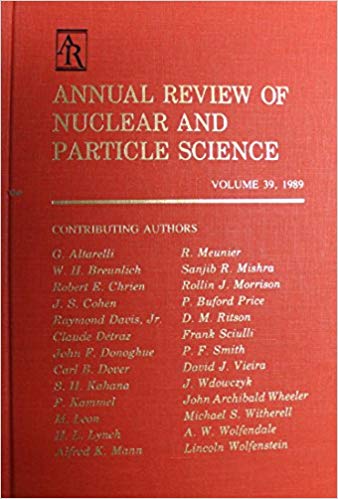Multiwavelength and Multimessenger Counterparts of Fast Radio Bursts
IF 9.1
2区 物理与天体物理
Q1 PHYSICS, NUCLEAR
Annual Review of Nuclear and Particle Science
Pub Date : 2024-09-26
DOI:10.1146/annurev-nucl-102020-124444
引用次数: 0
Abstract
Fast radio bursts (FRBs) are brief, highly dispersed bursts detected in the radio band that originate from cosmological distances. The only such event detected in the Milky Way Galaxy, FRB 20200428D—which was associated with an X-ray burst emitted by a magnetar named SGR J1935+2154—revealed the first case of a multiwavelength counterpart of an FRB. Counterparts in other wavelengths accompanying or following FRBs, as well as the bright emission associated with the progenitor of the FRB engine, have been proposed in various FRB models, but no robust detection has been made so far. In general, FRBs as we know them are not favored multimessenger emitters. Nonetheless, possible neutrino and gravitational wave emission signals associated with FRBs or FRB-like events have been discussed in the literature. Here I review these suggested multiwavelength and multimessenger counterparts of FRBs or FRB-like events and the observational progress in searching for these signals. Topics include multiwavelength (X-rays, γ-rays, optical) emission and neutrino emission from FRBs within the framework of the magnetar source models and possible FRB-like events associated with gravitational waves.快速射电暴的多波长和多信使对应物
快速射电暴(FRB)是在射电波段探测到的源自宇宙学距离的短暂、高度分散的爆发。在银河系中探测到的唯一一次此类事件--FRB 20200428D--与一颗名为 SGR J1935+2154 的磁星发射的 X 射线暴有关--首次揭示了 FRB 的多波长对应物。在各种FRB模型中都提出了伴随或跟随FRB的其他波长的对应物,以及与FRB引擎原生体相关的明亮发射,但迄今为止还没有进行过强有力的探测。一般来说,我们所知道的 FRB 并不是多信使发射器。尽管如此,文献中还是讨论了与 FRB 或类似 FRB 事件相关的可能的中微子和引力波发射信号。在这里,我将回顾这些被认为是 FRB 或类似 FRB 事件的多波长和多信使对应信号,以及在搜寻这些信号方面的观测进展。主题包括磁星源模型框架内FRB的多波长(X射线、γ射线、光学)发射和中微子发射,以及与引力波相关的可能的类FRB事件。
本文章由计算机程序翻译,如有差异,请以英文原文为准。
求助全文
约1分钟内获得全文
求助全文
来源期刊
CiteScore
21.50
自引率
0.80%
发文量
18
期刊介绍:
The Annual Review of Nuclear and Particle Science is a publication that has been available since 1952. It focuses on various aspects of nuclear and particle science, including both theoretical and experimental developments. The journal covers topics such as nuclear structure, heavy ion interactions, oscillations observed in solar and atmospheric neutrinos, the physics of heavy quarks, the impact of particle and nuclear physics on astroparticle physics, and recent advancements in accelerator design and instrumentation.
One significant recent change in the journal is the conversion of its current volume from gated to open access. This conversion was made possible through Annual Reviews' Subscribe to Open program. As a result, all articles published in the current volume are now freely available to the public under a CC BY license. This change allows for greater accessibility and dissemination of research in the field of nuclear and particle science.

 求助内容:
求助内容: 应助结果提醒方式:
应助结果提醒方式:


